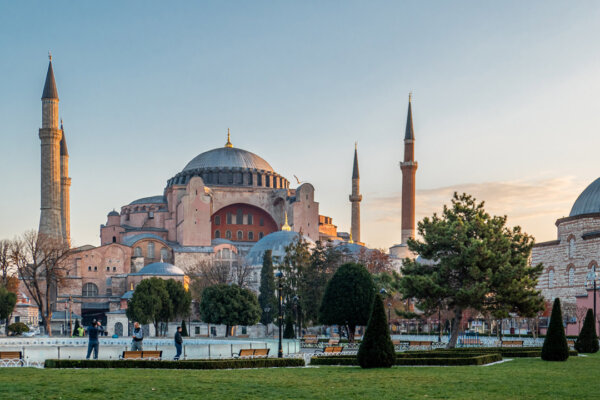FRANCE – Considered the “Gem of Renaissance Art in France,” the nearly 600-year-old Château d’Amboise attracts visitors with the use of virtual reality technology.
Château d’Amboise is one of the prominent structures in the Loire Valley, a UNESCO World Heritage site in France. Due to its strategic location, Amboise was chosen as a refuge and observation post for defense since prehistoric times. Over thousands of years, this land has witnessed the footsteps of Romans, Vikings, and eventually came under the management of the Amboise-Chaumont family. The collapse of this family marked the beginning of the construction of Château d’Amboise into an architectural masterpiece, praised as “one of the starting points of the Renaissance.”
In 1515, Leonardo da Vinci, the greatest artist in history, came to Château d’Amboise at the invitation of King Francis I. Leonardo spent his final years at Clos Lucé, a few hundred meters from Château d’Amboise, enjoying special favor with a private underground passage connecting him to the King’s castle for discussions. Thus, Château d’Amboise is closely linked to the name of Leonardo da Vinci, and many historians believe it to be the final resting place of this Italian polymath.

The exterior appearance of the castle remains almost intact.
Today, Château d’Amboise attracts tourists from around the world. They come not only to admire a Renaissance architectural masterpiece but also to visit Leonardo da Vinci and experience the application of modern virtual reality technology at a historic site.
Virtual reality technology is widely applied at many attractions in France and Europe, providing tourists with detailed and vivid perspectives on the places they visit, making history, culture, and art more appealing and unique. It also helps reduce waste as tourists no longer need individual guidebooks, brochures, or maps.
Upon entering Château d’Amboise, the receptionist will ask visitors if they want to use the History Pad. If the answer is yes, they will be provided with a large-screen tablet with a strap. This is a narration tool applying virtual reality technology, replacing traditional tour guides. With this tool, each visitor has their “personal guide,” able to move at their own pace, revisit interesting rooms, and take photos as long as they like.
Upon entering the first room, visitors may be “astonished.” The current state is just an empty room with a few plants and chairs, but when visitors scan the QR code in the room, the tablet will display a 3D image of the same room from centuries ago, accompanied by multilingual narration. It’s the room of the guards. On the screen, a soldier in contemporary attire is drinking water at a large wooden table, another soldier stands attentively looking out the window. Their weapons are displayed on a chest against the wall, and at the end of the room, the fireplace is ablaze with a warm red flame.
Entering the grand hall, where the ancient courtiers were received, visitors only see a few antique-style candle stands. But on the History Pad, images of dozens of aristocrats dressed in luxurious, vibrant attire, engaging in lively conversations, are displayed. Not only their clothing but also their shoes, hats, and accessories are detailed, combining aesthetics with the status and fame of each family. In this room, by tilting the History Pad to a different angle, visitors can also admire the lavish royal banquet, with a long table displaying elaborate dishes reserved for the wealthy aristocrats. Under the candlelight, on the table are various silver dishes, and even the intricately engraved patterns on the plate rims are meticulously described by 21st-century graphic designers.
The visual effectiveness of virtual reality technology is particularly impressive. Even on the History Pad, there are interactive games to engage children and teenagers. While this technology is not new, the French excel in its meticulous research and aesthetic reconstruction, bringing the glorious past closer to the viewer.
Like other castles of the French royalty and nobility, Château d’Amboise also has functional rooms such as a music room, the small living room of the castle’s lady, a children’s room, and a library. In each space, visitors can admire every piece of furniture, as well as the clothing and everyday items of the past, all displayed in detail. Château d’Amboise also exhibits the painting “The Death of Leonardo da Vinci” by Ménageot, painted in 1781, to remind visitors that this place witnessed the final years of the genius.
After visiting the castle, visitors return the History Pad at the reception, and no additional fees are required, apart from the admission fee for the castle purchased in advance. Tickets for Château d’Amboise can be purchased online, and on-site, visitors only need to present their phone with the QR code for scanning. The ticket is valid for six months from the date of purchase, priced at 16.4 euros for adults, 10.5 euros for children under 18, and 13.7 euros for students.

Furniture and some items within the room
Château d’Amboise is two hours by train from Paris. Visitors can explore many other famous castles in the Loire Valley, such as Château de Chambord, Château de Chenonceau, and Château of Sully-sur-Loire.






















[…] Readmore: The Great Mosque of Hagia Sophia in Turkey – Everything You Need to Know. […]